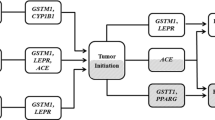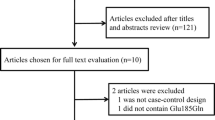Abstract
Purpose
To clarify the role of genetic polymorphisms of GSTO1 (rs4925) and GSTO2 (rs156697) in individual susceptibility to urinary bladder cancer.
Methods
Case–control study consisting of 187 patients with histologically confirmed transitional cell carcinoma (TCC) of urinary bladder and 140 age- and gender-matched cancer-free controls was carried out. Genotyping of GSTO1 and GSTO2 was performed by polymerase chain reaction–restriction fragment length polymorphism (PCR–RFLP).
Results
We found that carriers of mutant GSTO2*G/G genotype were at increased risk of the development of TCC (OR 2.6, 95 % CI 1.2–5.8, p = 0.041), while GSTO1 rs4925 polymorphism was not significantly associated with TCC risk (p = 0.450). According to smoking status, smokers with GSTO2*G/G genotype had significantly higher risk of TCC of urinary bladder (OR 4.3, 95 % CI 1.6–11.2, p = 0.003) compared to wild-type carriers with no smoking history. We further analyzed the effects of GSTO1/GSTO2 haplotypes on TCC risk, based on the linkage disequilibrium found for GSTO1 (rs4925) and GSTO2 (rs156697) (D′ = 0.309, p = 0.001). The study subjects with GSTO1*C/GSTO2*G (GSTO1 wild-type/GSTO2 mutant) haplotype were at the highest risk of the development of transitional cell carcinoma of urinary bladder (OR 2.8, 95 % CI 1.5–5.2, p = 0.002).
Conclusions
Our results indicate that GSTO1*C/GSTO2*G haplotype is associated with increased risk of TCC. The modifying effect of GSTO2*G/G genotype on individual susceptibility to TCC is more pronounced, when associated with smoking.
Similar content being viewed by others
References
Sexton WJ, Wiegand LR, Correa JJ, Politis C, Dickinson SI, Kang LC (2010) Bladder cancer: a review of non-muscle-invasive disease. Cancer Control 17:256–268
Hayes JD, Flanagan JU, Jowsey IR (2005) Glutathione transferases. Annu Rev Pharmacol Toxicol 45:51–88
Matic M, Pekmezovic T, Djukic T, Mimic-Oka J, Dragicevic D, Krivic B, Suvakov S, Savic-Radojevic A, Pljesa-Ercegovac M, Tulic C, Coric V, Simic T (2013) GSTA1, GSTM1, GSTP1, and GSTT1 polymorphisms and susceptibility to smoking-related bladder cancer: a case-control study. Urol Oncol 31(7):1184–1192
Kang HW, Song PH, Ha YS, Kim WT, Kim YJ, Yun SJ, Lee SC, Choi YH, Moon SK, Kim WJ (2013) Glutathione S-transferase M1 and T1 polymorphisms: susceptibility and outcomes in muscle invasive bladder cancer patients. Eur J Cancer 49(14):3010–3019
Gong M, Dong W, An R (2012) Glutathione S-transferase T1 polymorphism contributes to bladder cancer risk: a meta-analysis involving 50 studies. DNA Cell Biol 31(7):1187–1197
Whitbread AK, Masoumi A, Tetlow N, Schmuck E, Coggan M, Board PG (2005) Characterization of the omega class of glutathione transferases. Methods Enzymol 401:78–99
Wang YH, Yeh SD, Shen KH, Shen CH, Juang GD, Hsu LI, Chiou HY, Chen CJ (2009) A significantly joint effect between arsenic and occupational exposures and risk genotypes/diplotypes of CYP2E1, GSTO1 and GSTO2 on risk of urothelial carcinoma. Toxicol Appl Pharmacol 241:111–118
Chung CJ, Pu YS, Su CT, Huang CY, Hsueh YM (2011) Gene polymorphisms of glutathione S-transferase omega 1 and 2, urinary arsenic methylation profile and urothelial carcinoma. Sci Total Environ 409(3):465–470
Menon D, Board PG (2013) A role for Glutathione transferase Omega 1 (GSTO1-1) in the glutathionylation cycle. J Biol Chem 288(36):25769–25779
Tew KD, Townsend DM (2012) Glutathione-S-transferases as determinants of cell survival and death. Antioxid Redox Signal 17:1728–1737
Zhou H, Brock J, Liu D, Board PG, Oakley AJ (2012) Structural insights into the dehydroascorbate reductase activity of human omega-class glutathione transferases. J Mol Biol 420:190–203
Sanguansin S, Petmitr S, O-Charoenrat P, Pongstaporn W (2012) Association of glutathione S-transferase omega gene polymorphisms with progression of head and neck cancer. Mol Biol Rep 39(12):10915–10920
Masoudi M, Saadat I, Omidvari S, Saadat M (2011) Association between N142D genetic polymorphism of GSTO2 and susceptibility to colorectal cancer. Mol Biol Rep 38(7):4309–4313
Djukic TI, Savic-Radojevic AR, Pekmezovic TD, Matic MG, Pljesa-Ercegovac MS, Coric VM, Radic TM, Suvakov SR, Krivic BN, Dragicevic DP, Simic TP (2013) Glutathione S-transferase T1, O1 and O2 polymorphisms are associated with survival in muscle invasive bladder cancer patients. PLoS One 8(9):e74724
Savic-Radojevic A, Mimic-Oka J, Pljesa-Ercegovac M, Opacic M, Dragicevic D, Kravic T, Djokic M, Micic S, Simic T (2007) Glutathione S-transferase-P1 expression correlates with increased antioxidant capacity in transitional cell carcinoma of urinary bladder. Eur Urol 52(2):470–477
Piaggi S, Raggi C, Corti A, Pitzalis E, Mascherpa MC, Saviozzi M, Pompella A, Casini AF (2010) Glutathione transferase omega 1-1 (GSTO1-1) plays an anti-apoptotic role in cell resistance to cisplatin toxicity. Carcinogenesis 31(5):804–811
Engel LS, Taioli E, Pfeiffer R, Garcia-Closas M, Marcus PM, Lan Q, Boffetta P, Vineis P, Autrup H, Bell DA, Branch RA, Brockmöller J, Daly AK, Heckbert SR, Kalina I, Kang D, Katoh T, Lafuente A, Lin HJ, Romkes M, Taylor JA, Rothman N (2002) Pooled analysis and meta-analysis of glutathione S-transferase M1 and bladder cancer: a HuGE review. Am J Epidemiol 156:95–109
Marahatta SB, Punyarit P, Bhudisawasdi V, Paupairoj A, Wongkham S, Petmitr S (2006) Polymorphism of glutathione S-transferase omega gene and risk of cancer. Cancer Lett 236:276–281
Piacentini S, Monaci PM, Polimanti R, Manfellotto D, Fuciarelli M (2013) GSTO2*N142D gene polymorphism associated with hypothyroidism in Italian patients. Mol Biol Rep 40:1967–1971
Tian W, Wang Y, Xu Y, Guo X, Wang B, Sun L, Liu L, Cui F, Zhuang Q, Bao X, Schley G, Chung TL, Laslett AL, Willam C, Qin B, Maxwell PH, Esteban MA (2014) The hypoxia-inducible factor renders cancer cells more sensitive to vitamin C-induced toxicity. J Biol Chem 289(6):3339–3351
Traber MG, Stevens JF (2011) Vitamins C and E: beneficial effects from a mechanistic perspective. Free Radic Biol Med 51(5):1000–1013
Li YJ, Oliveira SA, Xu P, Martin ER, Stenger JE, Scherzer CR, Hauser MA, Scott WK, Small GW, Nance MA, Watts RL, Hubble JP, Koller WC, Pahwa R, Stern MB, Hiner BC, Jankovic J, Goetz CG, Mastaglia F, Middleton LT, Roses AD, Saunders AM, Schmechel DE, Gullans SR, Haines JL, Gilbert JR, Vance JM, Pericak-Vance MA, Hulette C, Welsh-Bohmer KA (2003) Glutathione S-transferase omega-1 modifies age-at-onset of Alzheimer disease and Parkinson disease. Hum Mol Genet 12:3259–3267
Yanbaeva DG, Wouters EF, Dentener MA, Spruit MA, Reynaert NL (2009) Association of glutathione-S-transferase omega haplotypes with susceptibility to chronic obstructive pulmonary disease. Free Radic Res 43:738–743
Pljesa-Ercegovac M, Savic-Radojevic A, Dragicevic D, Mimic-Oka J, Matic M, Sasic T, Pekmezovic T, Vuksanovic A, Simic T (2011) Enhanced GSTP1 expression in transitional cell carcinoma of urinary bladder is associated with altered apoptotic pathways. Urol Oncol 29(1):70–77
Acknowledgments
This work was supported by the Grant 175052 from the Serbian Ministry of Education, Science and Technological Developmental.
Conflict of interest
The authors declare that they have no conflict of interest.
Ethical standard
All procedures performed in studies involving human participants were in accordance with the ethical standards of the institutional and/or national research committee and with the 1964 Declaration of Helsinki and its later amendments or comparable ethical standards.
Author information
Authors and Affiliations
Corresponding author
Rights and permissions
About this article
Cite this article
Djukic, T., Simic, T., Radic, T. et al. GSTO1*C/GSTO2*G haplotype is associated with risk of transitional cell carcinoma of urinary bladder. Int Urol Nephrol 47, 625–630 (2015). https://doi.org/10.1007/s11255-015-0933-0
Received:
Accepted:
Published:
Issue Date:
DOI: https://doi.org/10.1007/s11255-015-0933-0




